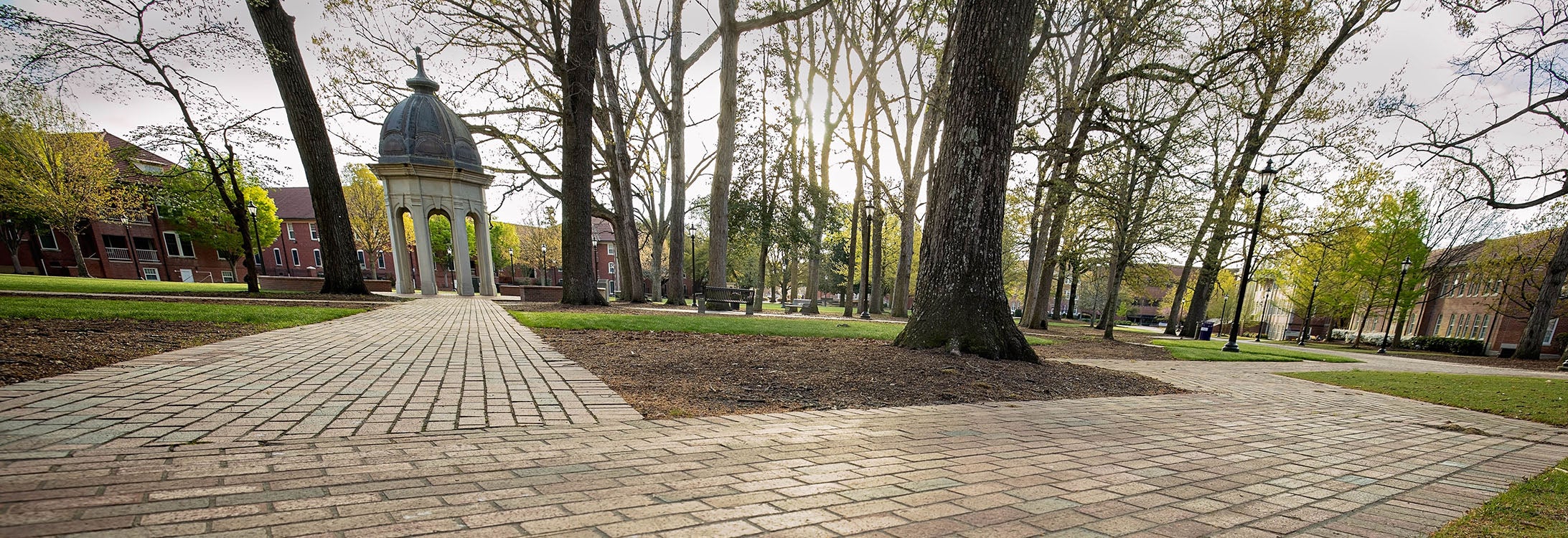LEANING IN
Pirate Nation adapts to changes in teaching, learning, operations during pandemic

Dr. Ron Mitchelson shares a moment at home with labs Gracie and Birdy. (Contributed photo)
As East Carolina University students switched from in-person to distance education-only classes last week, hundreds of faculty and staff worked from home.
Face-to-face lectures or meetings were replaced by virtual gatherings from kitchen tables through WebEx, Zoom or other video conferencing platforms because of the coronavirus pandemic.
Still other essential personnel remained on campus as students moved out of residence halls, and COVID-19 testing was set up on the health sciences campus.
Regardless of location, ECU students, faculty and staff are working in ways that weren’t expected when the spring semester began.
“Pirate Nation is leaning in and doing its part to meet this challenge as we always do. Our students, staff and faculty have adapted in remarkable ways,” said Dr. Ron Mitchelson, interim chancellor. “I look forward to welcoming everyone back to East Carolina after this storm is behind us.”
Alone Together
While apart, faculty members are providing coursework to reach students wherever they are.“My students are adjusting well and have stayed very well connected,” said Andrew “Dewey” Pickett, instructor in the Department of Health Education and Promotion. “Many have shared being overwhelmed by what is, essentially, a brand-new start of a new semester. That creates some anxiety that we need to be aware of. Live webcams have proved invaluable in maintaining a sense of normalcy for class and making it possible for the students to see one another. They need that interaction to not feel so removed from the university and a place they’ve called home.”
Pickett teaches several athletic training courses with clinical components, including an education lab-based course requiring 200 hours at an athletic training clinical site.
“The second half of the course — the post-spring break portion — is practical testing and case study-based that needed a major overhaul in switching to online instruction,” he said. “With telehealth being adopted in most, if not all, medical sites or clinics with COVID-19, I shifted the course to take this approach in WebEx, with telehealth practicals as if our trainers were performing this care in the real world.
“Students have welcomed the idea and I look forward to exploring a new dynamic in this learning environment. Case studies will now be presented live in WebEx with the whole class joining in virtually for a seamless transition.”

Music professor Gabriel DiMartino teaches asynchronously in his newly-purpose-built home studio. (Contributed photo)
Pickett also has enjoyed the humor and creativity his students are demonstrating. “One of my students set up a green screen behind his desk and projected a photo of our actual classroom so it looked like he was there. Another joins class from his DJ booth, so he’s now in charge of intro music while everyone’s logging in,” Pickett said. And there are new, four-legged class attendees. “There are lots of dogs peering over the edge of tables and cats walking across keyboards giving me death stares.”
In the School of Music, professor Gabriel DiMartino teaches asynchronously in his newly-purpose-built home studio. Using Canvas, his students record videos for him to evaluate, and he can respond in kind using either the computer or his iPhone. For music, good headphones and a spaced-pair of microphones are essential for evaluating and recording. He also films a series of TikTok videos for eastern North Carolina public school students learning from home since schools were closed.
“We’ve never seen a crisis like this in our lives, so there are a lot of ‘unknowns’ that can pop up,” DiMartino said. “By alternating videos on Canvas, students can feel free to do their assignments when it is possible, and I can give thoughtful responses despite any challenges I face. It makes it easy to keep the quality of the educational message high without inconveniencing the students or their families.”
Marina Walker, teaching assistant professor of physics, was an early adopter of Canvas and began recording videos last summer. She has more than 100 videos, which are available on YouTube, and now is making videos for a course she has never taught online. Her current videos are a screen-capture only.
“As students are watching, they can pause the video and write a comment at the exact moment where they have a question,” Walker said. “I also like the different options for organizing content. I like to create a separate module for each week, so students can access everything they need for that week in one location. I also have a weekly checklist for items to complete each day that I feature on the homepage. Students can click on each item and it will take them directly to the video or assignment they need to complete.”
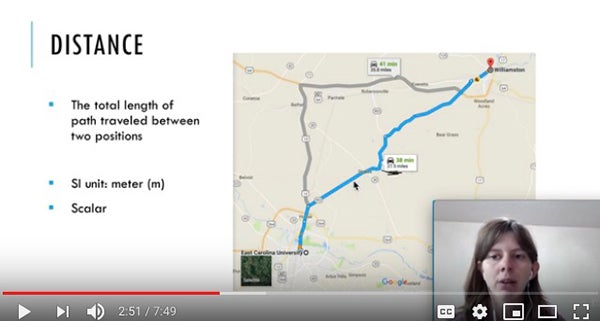
Marina Walker, teaching assistant professor of physics, was an early adopter of Canvas and began recording videos last summer.
(Contributed photo)
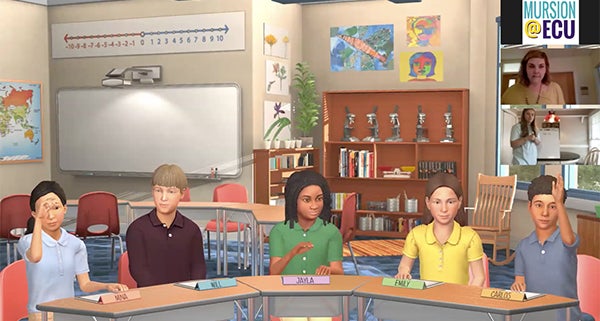
Dr. Carrie Lee observes Katie Edwards, a junior special education major, conducting a number talk with the Mursion virtual simulator through Zoom. (Contributed photo)
In the College of Education, Dr. Carrie Lee is ensuring her mathematics education students still have the chance to practice teaching by using Mursion, a virtual simulator.
Lee said that while students normally visit the Mursion Lab in the Speight building, she had already begun using Zoom for two of her sections before classes were moved online. She has created scenarios through the software that let ECU students teach math lessons to virtual avatars.
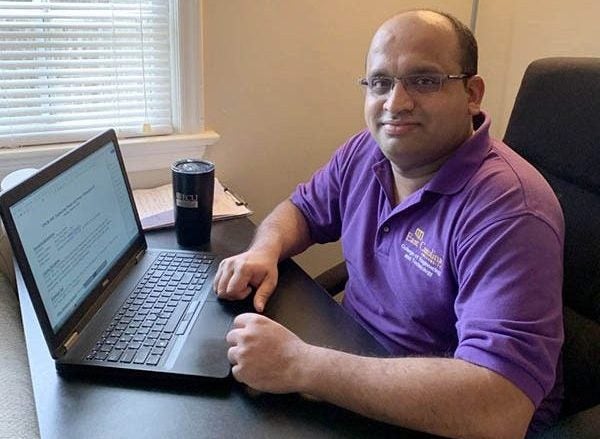
Dr. Praveen Malali uses Blackboard to post PowerPoint slides and records lectures using Mediasite. (Contributed photo)
“It’s pushing us forward to think about how we can create these rehearsals and enactments of teaching outside of the classroom that can be used in the future when we’re back face-to-face,” she said. “I would have enjoyed doing this in another type of environment, but would I have been forced to do it if this wasn’t happening? I don’t know.”
With 32 students enrolled in the Engineering Design and Project Management II class, Dr. Praveen Malali is using Blackboard to post PowerPoint slides and is recording lectures to share with students using Mediasite — all from his home.
“I have also been able to hold online meetings with my research students using WebEx,” said Malali, research director at the Center for Sustainable Energy and Environmental Engineering in the College of Engineering and Technology. “My students have also been able to switch to an online way of doing things quite well. I receive emails from my students about the course and have been in contact with them through Blackboard and emails. Although this new experience has made me aware of several effective online class delivery tools, I definitely miss the in-class interactions with my students.”
Not being able to talk with current and prospective students in person has challenged Margaret Turner, director of admissions and recruitment for the ECU Honors College.
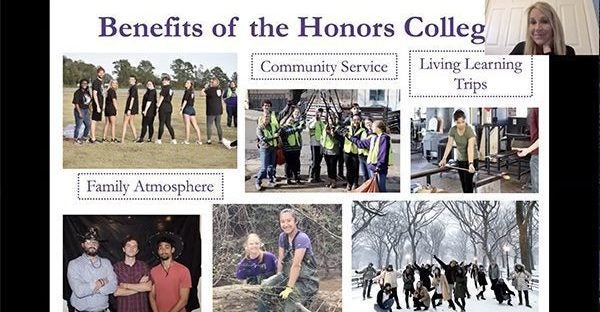
Margaret Turner discusses the benefits of the Honors College using Zoom. (Contributed photo)
“I think the most difficult part for me is just missing the daily human interaction with my colleagues and our students,” Turner said. “I’m so thankful for technology and sometimes being stretched in this area is good. However, it reminds me how important human interaction really is to all of us.”
High school seniors are still making decisions about which university they will attend in the fall, so Turner has scheduled informational Zoom sessions where she, Honors College Associate Dean Dr. Todd Fraley, and current honors students will talk about the benefits of the college and their experiences.
“Our goal is to take what is already a stressful time for these seniors and to help minimize that for them by being supportive in this part of the process,” Turner said.
Supporting current ECU students continues in the College of Business’ Undergraduate Advising Center. The eight-person team moved all its technologies from campus to their home offices, and students have been communicating with their academic advisors via email, Microsoft Teams, WebEx or by phone. The advising team is meeting weekly and prepping for summer and fall registration, which began March 27.
“We can truly do everything remotely that we are able to do in the office except talk face to face with students,” said Kevin Williams, director of COB’s undergraduate advising programs. “Most of our advisors have been fully booked every 30 minutes with student appointments over the past few weeks. That aspect of our service hasn’t changed.”
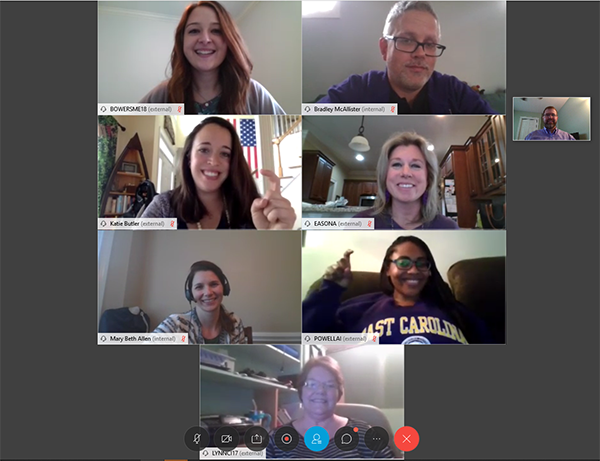
The eight-member College of Business undergraduate advising team holds a teleconference to prep for summer and fall registration. (Contributed photo)
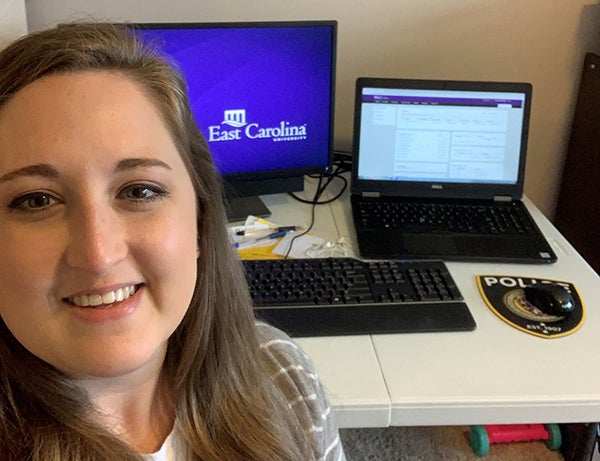
Cara Gohn, who oversees the university’s online research administration system, eTRACS, is set up in her children’s playroom. (Contributed photo)
Another area that hasn’t slowed due to the coronavirus is research. Faculty members still need support for proposals, and they are continuing research projects despite being away from their labs and students.
Cara Gohn oversees the university’s online research administration system, eTRACS. While some local and state government offices have closed to the public, federal agencies, including the National Science Foundation and National Institutes of Health, are still up and running.
“Proposals for federal funding are submitted within eTRACS, so the system has to continue to run smoothly and our office must continue to provide support,” she said. “We have all done our part to keep the office running during hurricanes, snowstorms and other closures; this pandemic is no different.”
Despite the challenges of working from home, Gohn said there are positive moments to be had.
“I am currently set up in my kid’s playroom,” Gohn said. “The playroom is upstairs and out of the way, so I do get privacy, but I often share the space with my two kids and husband. Yesterday I took a break from work and we all did yoga together. Those breaks are the sweetest.”
On the Front Lines
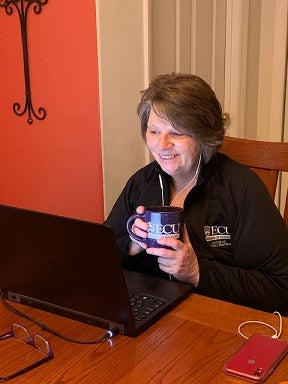
Dr. Jan Tillman works with College of Nursing students from her desktop at home. (Contributed photo)
Meanwhile, on ECU’s health sciences campus, faculty continue to teach while caring for patients.
Dr. Jan Tillman, a family nurse practitioner and clinical associate professor in the Doctor of Nursing Practice program, has been helping her students — some of whom are working on the front lines of the pandemic — find ways to apply their real-world experiences to their coursework, complete their clinical requirements and graduate on time.
Many of Tillman’s students are working nurses who are caring for COVID-19 patients while also pursuing advanced degrees.
“I have talked with several students who will not start their doctoral projects for several semesters, but who are doing amazing work that is innovative and necessary right now, in the trenches, in their places of employment, who need help learning to do a policy and procedure really quickly. Or they need help learning how to comb the literature really quickly.”
As Tillman works to find ways to alleviate additional burdens on students caused by the pandemic, she has been consulting with nursing leadership to find ways to apply students’ real-life experience to fit their educational requirements.
“I’m asking myself, ‘How can I help synergize this to help them get ahead of the game so that this really meaningful real-time work becomes their DNP project? How can I help this student to take the worst situation right now to actually metamorphosize it into something valuable, so that they’re not just doing this today that will be gone at the end of COVID?’” she said.
Tillman has encountered many of the challenges that other faculty within the Division of Health Sciences are facing — providing clinical experiences while navigating new restrictions on students taking part in face-to-face clinicals. To adapt, the college has purchased new online learning tools, Tillman and other faculty have created case studies, and they’ve expanded the use of their virtual clinic for simulated clinical experiences.
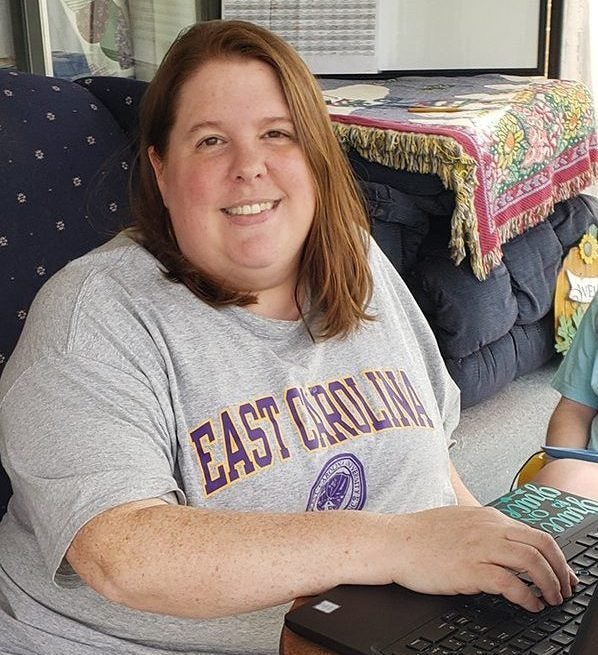
Kim Stokes, clinical associate professor of physician assistant studies, has been focused on how to keep students moving and on track. (Contributed photo)
The College of Allied Health Sciences’ Physician Assistant Studies program also is developing creative solutions for students to meet course requirements.
“The first thing we did when we pulled them out (of clinicals) was that we implemented our hurricane contingency plan,” said Kim Stokes, clinical associate professor of physician assistant studies and the program’s director of clinical education. “A couple years ago we made a hurricane contingency plan so that if you were in Wilmington and couldn’t go to clinics, but someone in Raleigh could, you’d still have things you could do to keep you on track and keep you moving.”
The clinical coordinating team has talked with national physician assistant organizations to get ideas to keep students moving and on track.
“We set up once-a-week cases with them based off the courses they were in. The faculty send out cases to students in small groups and each student is assigned to lead a case and then we get together on WebEx and have a roundtable session,” Stokes said. “They talk us through their critical reasoning for the case and get ideas from other students and we facilitate that learning in that way.”
Her last couple of days, she said, have been spent figuring out what to do if students can’t go back into rotations. “We have some ideas of alternative electives or courses that we can restructure or reorganize to keep them active as students without having to delay graduation for as long as possible,” Stokes said.
Dr. Luan Lawson, associate professor in emergency medicine and associate dean for curricular innovation in medical education, assessment and clinical academic affairs in the Brody School of Medicine, said labs posed a particularly challenging form of education to transform into online learning. “Our neuroanatomy faculty developed creative methods to deliver the content by video that have been so positively received that students recommended continuing in the future,” she said.
Lawson said most of the success of rapidly switching to virtual teaching stems from teamwork between academic affairs leaders and faculty.
“Our entire foundational sciences curriculum was converted to virtual delivery in two days,” she said. “The faculty have demonstrated tremendous dedication to our students as they have worked nonstop to ensure our learners have been able to remain engaged in the curriculum.”
Lawson called the COVID-19 pandemic “the most complex situation we have ever encountered in modern medical education.”
Dr. Johanna Hannan, assistant professor of physiology, teaches first-year medical students and a neuroscience course for graduate students. “The biggest challenges have been how to test the students when we rely on computer lab testing centers. Additionally, many small group assignments have had to transition to essay-based work to allow for social distancing.”
Dr. Jamie DeWitt, associate professor of pharmacology and toxicology, is using a mix of electronic course material that was already available, as well as implementing WebEx and PowerPoint voiceovers.
“It’s mostly trial and error right now, but I’ve tried to be very communicative and transparent to the students,” DeWitt said. “I want to make sure that they realize these courses are not ‘online’ courses but courses where materials will now be delivered electronically. I’ve also asked them to be patient and I have placed the same expectations on myself.”
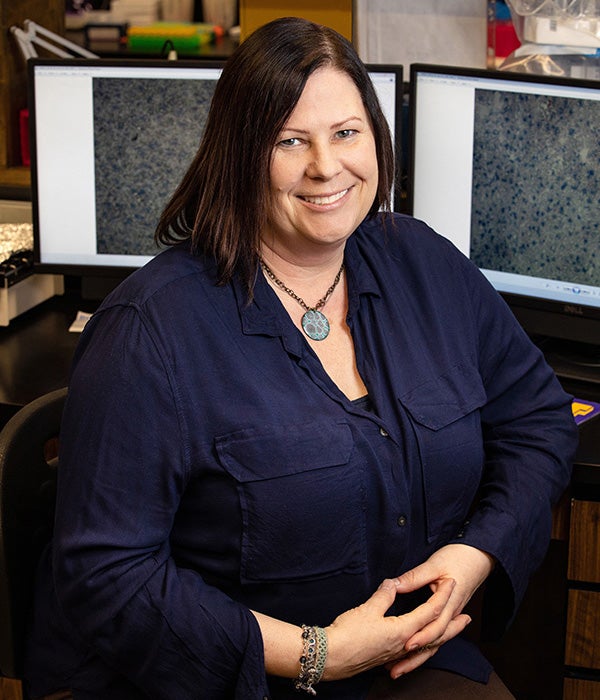
Dr. Jamie DeWitt, associate professor of pharmacology and toxicology, is using a mix of electronic course material, WebEx and PowerPoint voiceovers. (Contributed photo)
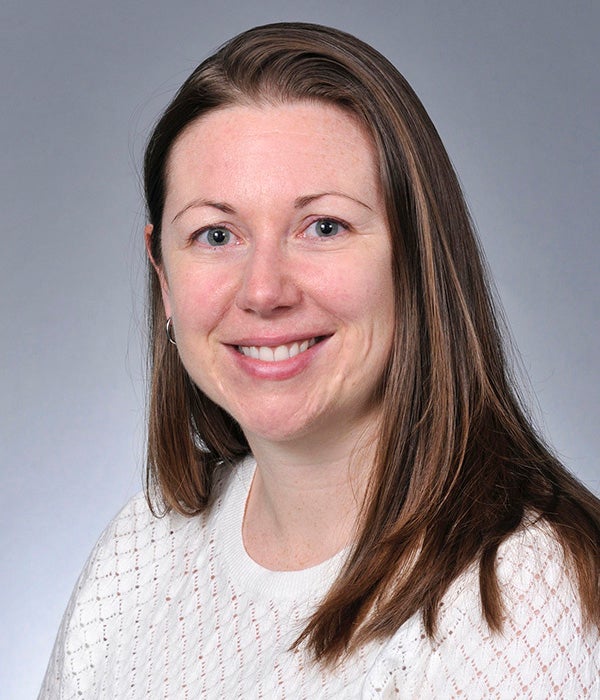
Dr. Johanna Hannan, assistant professor of physiology, has transitioned many small group assignments to essay-based work to allow for social distancing. (Contributed photo)
DeWitt said faculty are prepared to be flexible and adapt as needed.
“In the sciences, especially in the labs and I would imagine in the clinical arena, we have to be able to respond to new environmental health threats quickly and with all of our available tools. This is our world right now and we have to do the best we can do to adjust,” DeWitt said.
In the School of Dental Medicine, residents, faculty and staff continue to care for emergency patients at 10 locations statewide — keeping patients away from hospital emergency rooms during the pandemic. Many faculty and staff are teleworking in support of the school’s clinical operations, while others are working together remotely to redesign courses for online delivery to predoctoral students.
Behind the Scenes
While Joyner and Laupus libraries are closed, staff continue to provide virtual services and support including literature searching, information inquiry, document delivery and one-on-one consultations.
To ensure that students and faculty have access to the books and materials they need, Joyner’s circulation team is shipping requested items. Librarians are also scanning textbooks to make them electronically available to students who need them.
Joyner has loaned laptops to students who don’t have computer access away from campus, to the Center for Counseling and Student Development for teletherapy sessions, and to the undergraduate admissions team. The library also provided graphics tablets to the mathematics department, which make it possible for instructors to write or draw onscreen during WebEx sessions.
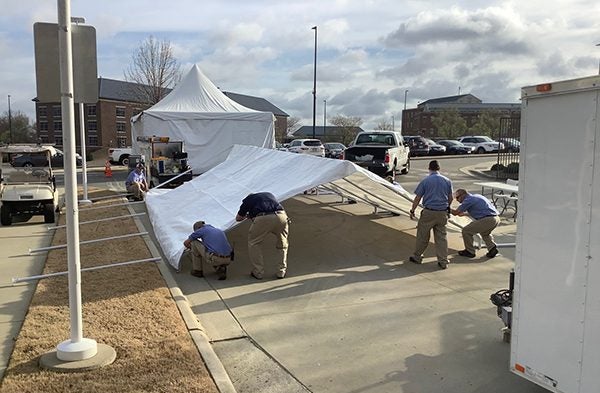
ECU facilities workers set up an outdoor physician-directed central COVID-19 testing location on the health sciences campus. (Contributed photo)
At Laupus, the professional writing consultant has transitioned to synchronous and asynchronous online assistance for the preparation of grant proposals, journal articles and other scientific manuscripts. Jamie Bloss also is producing new content for Laupus’ social media channels like this YouTube video.
Jana Schellinger, librarian liaison to the Brody School of Medicine, was called to assist Dr. Harry Ploehn, professor and dean of the College of Engineering and Technology, and his team in finding research about safely sanitizing N95 respirators for possible reuse in case of a shortage. “This has been an exciting team to be a part of as I know it is making a difference in current health care decisions,” Schellinger said.
Facilities workers on the health sciences campus were instrumental in setting up an outdoor physician-directed central COVID-19 testing location and ensuring traffic would flow smoothly. “Housekeeping provides critical support to the cleanliness of our clinics,” said Bill Bagnell, associate vice chancellor for campus operations.
Housekeeping also has been instrumental in cleaning residence halls vacated by students last week as well as providing support in Jones Hall, which remains open for about 50 students who couldn’t leave campus. Todd Dining Hall remains open for those students as well, which means refuse must be collected at both locations.
While staffing levels have been reduced, Bagnell said mandatory employees continue to report to campus to ensure buildings and grounds are maintained. “Things are very dynamic with campus operations right now,” he said. Elevators, fire alarms, HVAC, electrical systems and boiler operations continue 24/7. Construction is ongoing, including roof projects and the new life sciences and biotechnology building. “You can’t just stop in the middle of the project,” Bagnell said. “We’ve asked them to practice as much social distancing as possible.”
In university advancement, working remotely gave employees an opportunity to share glimpses into their temporary office spaces. An email thread with the division’s 60-plus person team became an impromptu “bring your pet to work day” and was filled with photos of happy dogs, lounging cats and even a yellow lizard. It was a light moment at the end of a productive week, said Vice Chancellor Chris Dyba.

Watson is the “coworker” of Caroline Tait, director of alumni marketing and communication. (Contributed photo)
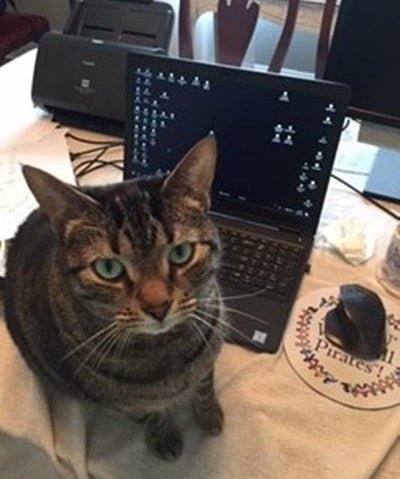
Bertie is “one of the two demanding bosses at my house,” shared ECU Foundation accountant Patrica Fritz. (Contributed photo)
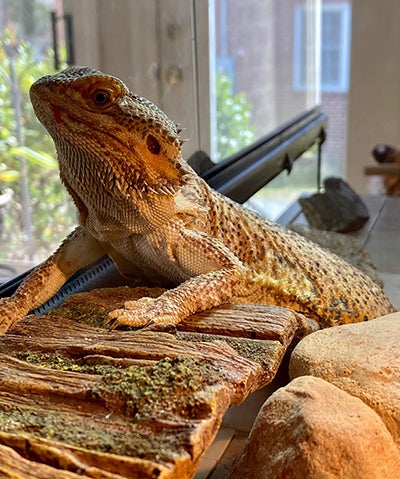
Athena the lizard is helping University Advancement Officer Melissa Adamson at home. (Contributed photo)
“I know it’s tough and challenging to perform our jobs right now, but I am so proud of the work you are doing,” Dyba wrote in an email. “I’m thrilled to report that fundraising continues, alumni relations continues important outreach, stewardship letters are being produced, board members are working on behalf of our foundations, and on and on. Pirate Nation is grateful.”

HR’s Justin Yeaman takes a selfie at home. (Contributed photo)
“As with any quick shift in business practices, there are bumps in the road, but I have been very happy with how our team has been able to adapt to such an unprecedented change. We’re lucky that we have folks who are flexible and willing to get outside of their comfort zones during a time like this to make it work.
“Pretty much all of our meetings are conducted via videoconferencing these days,” he said. “We have our leadership team meetings and project team meetings like we always have, just in this new format. With Microsoft Teams’ video-chat feature, popping into someone’s office has transformed into popping onto someone’s monitor for those quick conversations.”
Yeaman encouraged patience until things get back to normal.
“We need to give one another a little more grace these days,” Yeaman said. “Everyone is dealing with this change to some degree, and it’s not always easy.”
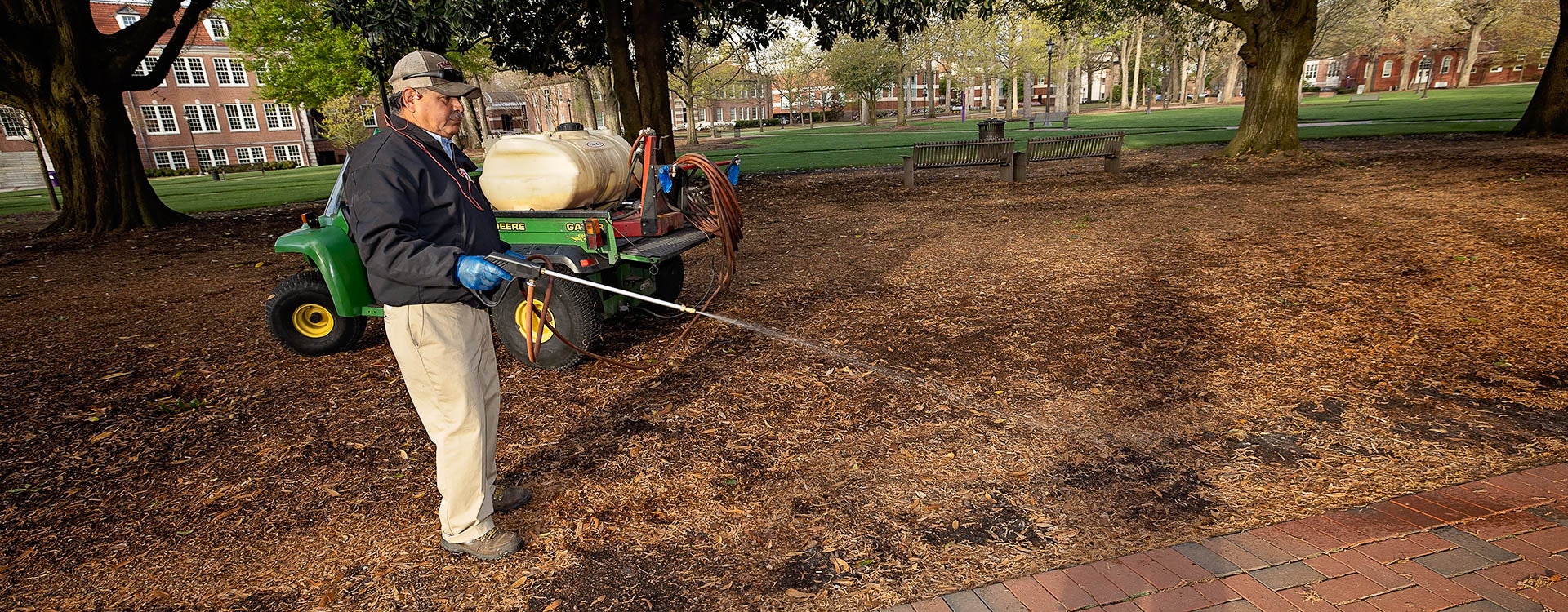
Jose Flores works on campus on March 26. (Photo by Cliff Hollis)
